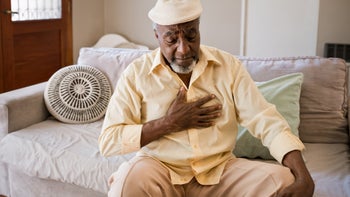
Poor Circulation? How to Know If You Have Peripheral Artery Disease (PAD) or Chronic Venous Insufficiency
Key takeaways:
Peripheral artery disease (PAD) and chronic venous insufficiency (CVI) are conditions that typically affect the blood vessels of the legs.
PAD is a disease of the arteries — the blood vessels that take oxygenated blood to the tissues.
CVI is a problem with the veins — the blood vessels that take deoxygenated blood from the tissues back toward the heart.
People with PAD can experience pain in their legs, while people with CVI tend to get leg swelling and varicose veins.

People often mix up peripheral arterial disease (PAD) and chronic venous insufficiency (CVI). That’s because they’re both vascular (blood vessel) problems that affect peripheral structures in the body, typically the legs and feet. PAD and CVI both cause issues with blood circulation, but the symptoms and treatments are different. At the same time, both conditions share some common risk factors, which means it’s possible to have both.
Here’s what you need to know about vascular diseases of the legs — and how to tell whether your problems are due to PAD, CVI, or both.
Peripheral artery disease vs. chronic venous insufficiency
The first step to appreciating the differences between PAD and CVI is understanding the different roles of arteries and veins.
Arteries are blood vessels that take oxygenated blood from the heart to all of the organs and tissues of the body. Arteries carry high pressure blood pumped out of the heart, so they have thick, muscular walls.
Veins are blood vessels that take deoxygenated blood back toward the heart from organs and tissues around the body. Venous blood has low pressure. It’s also working against gravity to get back to the heart. Veins have some special features that help them move venous blood along:
Vein walls are thin and floppy.
Veins have a system of valves that prevent blood from flowing backward.
Surrounding muscles, like in the legs, squeeze the veins to keep venous blood moving along.
Peripheral arterial disease
Like its name suggests, PAD is a problem that affects the arteries. So it affects the supply of oxygen-rich blood to the legs and vital organs (like the kidneys, gut, and brain).
More specifically, PAD is a narrowing or blockage of the arteries that carry blood to the organs and tissues. PAD is usually caused by cholesterol deposits (atherosclerosis) that form in the arteries. It’s a similar process to what happens in the heart to cause a heart attack.
Chronic venous insufficiency
CVI is a problem that affects the veins. So it affects the flow of blood back to the heart. Blood doesn’t flow freely back to the heart. Instead, it tends to settle in the legs. Usually CVI happens because the veins have been damaged in some way — either from a blood clot, previous injuries, or sitting or standing for long periods of time.
Symptoms of PAD vs. CVI
People with the beginning stages of PAD and CVI may not have any symptoms at all. But, when symptoms develop, they tend to be quite different. So paying attention to specific symptoms can help tell the difference between PAD and CVI. Let’s compare common symptoms of PAD and CVI:
| PAD symptoms | CVI symptoms |
|---|---|
| Tiredness, aching, or cramping in the legs, especially while walking (claudication) | Dull pain, tight or “tired” feeling in the legs |
| Coldness in lower legs and feet | Warm feeling in the legs, with varicose or spider veins |
| Loss of leg hair and slow toenail growth | Leg swelling (edema), especially after standing for long periods of time |
| Blue or pale skin | Dark, leathery skin |
| Ulcers on the toes and feet | Ulcers on the legs, especially near the ankles |
Risk factors for PAD and CVI
Both PAD and CVI share some common risk factors. People are more likely to have blood vessel issues if they have a family history of blood vessel problems, are older (over 50), and have a BMI in the overweight or obese category. But some risk factors are unique to each condition.
PAD is more common in people who have a history of:
Smoking
High cholesterol
CVI is more common in people who:
Have a history of a deep venous thrombosis (leg blood clot) or previous leg injury or surgery
Have a family history of CVI
Are pregnant
Are female
Stand for long periods of time or don’t get enough exercise
If any of these risk factors apply to you, it’s important that you discuss them with your healthcare provider. This promotes early detection of PAD and CVI. Plus, many of these are also common risk factors for conditions such as heart attack and stroke.
Getting a diagnosis of ‘poor circulation’ in the legs
If you think you could have PAD or CVI, the first step is to speak to your healthcare provider. They’ll ask you about your medical history, surgical history, and family history. They’ll also want to get a detailed description of your symptoms.
You’ll need to remove your shoes and socks so your provider can do a physical examination to:
Look closely at your legs and feet for skin discoloration, ulcers, and swelling
Check for temperature differences of your legs and feet
Feel for pulses (impulses in the arteries when the heart beats) in your legs and feet
If there’s anything out of the ordinary on your examination, most likely you’ll need additional tests.
Tests for PAD
If your provider thinks you may have PAD, they might order some of the following tests to help diagnose it:
Ankle-brachial index (ABI): This is a measurement that compares blood pressure in the arms and the legs to look for a drop off between the two.
Ultrasound: This test uses sound waves to look at blood flow in blood vessels and detect blockages.
Angiography: A provider injects contrast dye into the arteries and takes images to help find any blockages. They can do this with CT (computed tomography) or MR (magnetic resonance). A vascular specialist can also do an angiography procedure with X-rays and then treat any blockages at the same time.
Tests for CVI
If your provider thinks you may have CVI, they can use a special ultrasound scan of the leg veins to look at how the blood moves through them. Sometimes you’ll need additional tests — such as CT scans or MRIs — to look for an underlying reason why the veins are not properly draining blood back to the heart.
Treatments for PAD and CVI
PAD and CVI are different problems that affect different vessels, so the treatments are also different. Treatments for PAD help bring more blood flow to the legs and feet. Treatments for CVI focus on bringing blood from the legs back to the heart.
PAD treatments
Treatment for PAD typically centers on improving symptoms and preventing PAD from getting worse.
There are behavior and lifestyle changes you can make, such as:
Cutting out smoking
Getting regular checkups and treatment for medical conditions that increase your risk of PAD — like diabetes, high cholesterol, and high blood pressure
Starting a prescribed, structured walking program to help improve the blood flow in your legs
Medical treatments for PAD include:
Medications: Some medications can help with symptoms, like cilostazol and pentoxifylline.
Angioplasty: This is a procedure to open the blockage and improve blood flow through the artery. With the visual help of an X-ray, a specialist inflates a small balloon to open the artery. Sometimes the specialist inserts a wire-mesh scaffold (a stent) to keep the artery open.
Surgery: A surgeon can “bypass” a diseased artery to redirect blood flow around the narrowing or blockage.
CVI treatments
To decrease swelling and discomfort — and prevent CVI from becoming worse — there are several things to try before considering medications or procedures.
If you have CVI, try the following:
Avoid standing for prolonged periods of time.
Elevate your legs whenever possible.
Wear compression stockings.
Stay active, so your leg muscles help move blood from your legs back to the heart
If these measures aren’t enough, you may need:
Medications: Anticoagulants can help if you have a blood clot. Aspirin can help with venous ulcers. And you may need antibiotics if you develop an infection.
Minimally invasive procedures: Options include endovenous ablation or sclerotherapy to close damaged or problem veins and improve overall blood flow.
Surgery: Although rare, surgery usually involves tying a vein to close it or removing a problem vein to help the blood flow through healthy channels and back to the heart.
How to prevent blood vessel disease in your legs
You can take steps to prevent PAD and CVI by:
Getting more exercise
Maintaining a healthy weight
Making healthier food choices
Keeping up with your treatment for other medical conditions — like diabetes, high cholesterol, and high blood pressure.
It’s always a good idea to visit your healthcare team regularly. That way they can help get you on the right track with ways to prevent vascular disease and improve your overall health.
The bottom line
When people say they have poor circulation, they could have peripheral artery disease or chronic venous insufficiency. Both are blood vessel conditions that affect circulation — usually in the legs. While they share several of the same risk factors, they’re different problems that affect different types of blood vessels. So the symptoms, tests, and treatments for PAD and CVI are quite different.
If you’re having new or unusual symptoms in your legs — like pain or swelling — it’s best to check in with your healthcare team to see if problems with your arteries or veins may be the cause. You can help prevent both PAD and PVD by quitting smoking, getting regular exercise, keeping a healthy weight, and eating a healthy diet.
Why trust our experts?


References
American Heart Association. (2021). Peripheral angiography.
American Heart Association. (2021). Symptoms of PAD.
American Heart Association. (2021). What is peripheral artery disease (PAD)?.
Centers for Disease Control and Prevention. (2021). Peripheral arterial disease (PAD).
Eberhardt, R. T., et al. (2014). Chronic venous insufficiency. Circulation.
MedlinePlus. (2019). Vascular diseases.
Society for Vascular Surgery. (n.d.). Conditions.
Treat-Jacobson, D., et al. (2018). Optimal exercise programs for patients with peripheral artery disease: A scientific statement from the American Heart Association. Circulation.
Yao, P., et al. (2022). Varicose vein endovenous laser therapy. StatPearls.




